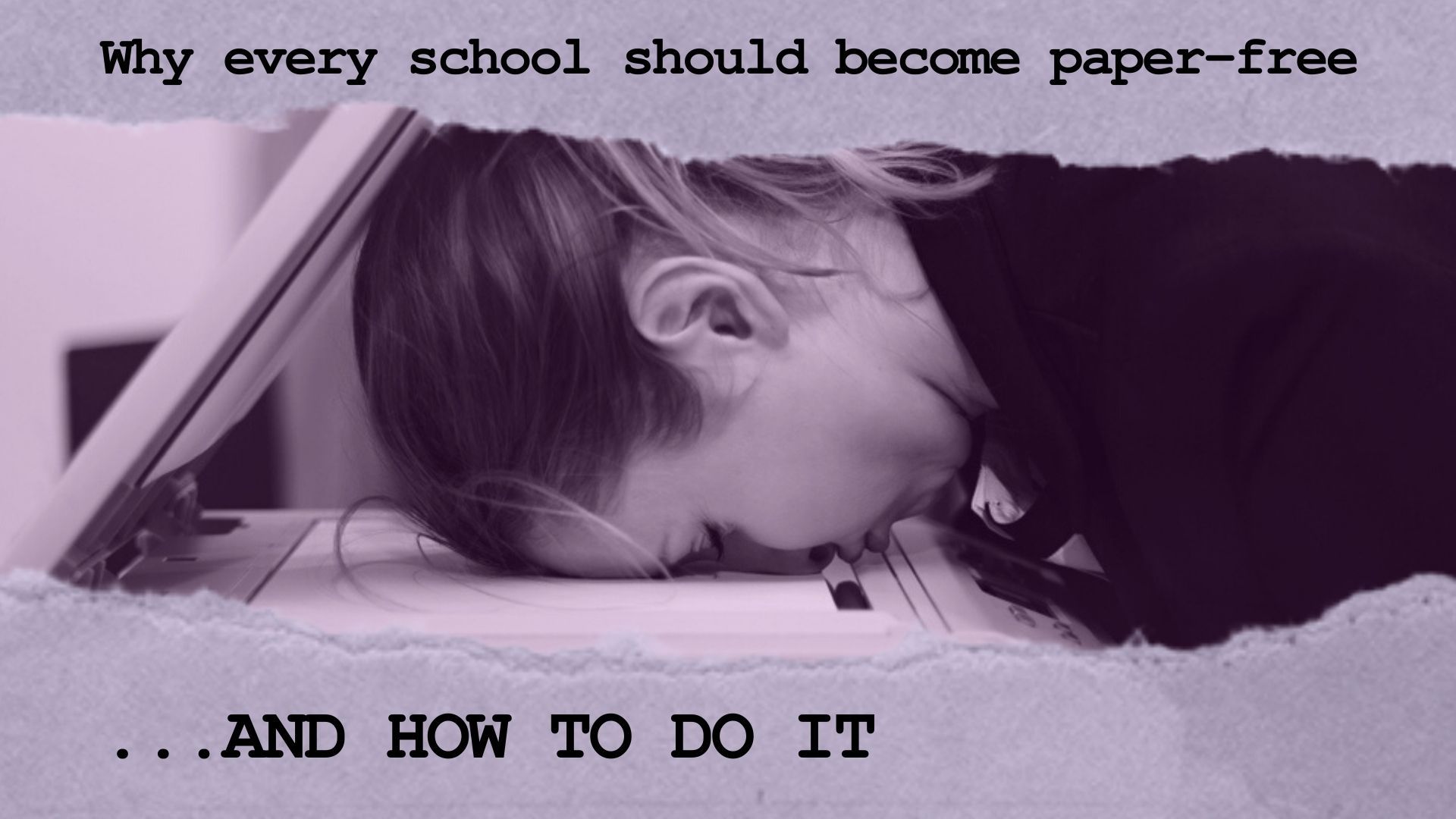
Why every school should become paper-free and how to do it
By Alan Dunleavy
The big issue of the day is Climate Change. From rising sea levels to emission of fossil fuels, from desertification to water and air quality, there are many issues currently being discussed at the highest levels of government, nationally and internationally. The COP26 summit in Glasgow was one of the major political events of the year.
What relation has all of this got to do with the humble TEFL school? What possible relation can Climate Change have to English teaching? I believe there is great waste in the TEFL sector, particularly concerning paper, and I have also discovered that when a teacher becomes more eco-friendly, there are unexpected benefits for everyone involved.
Anyone with pre-pandemic experience in ESL is familiar with the sight of teachers queuing impatiently at the one photocopier in their school’s possession, which routinely breaks down, occasionally leading to cries of frustration or accusations of planned obsolescence by the manufacturers! Another common occurrence is the grumbling of a school owner complaining about the cost of replenishing paper, ink and toner each month. A final observation frequently made is the sight of paper printouts sitting redundantly on a desk because a student didn’t show up to class and the teacher had prepared materials in anticipation of a full attendance for the group.
Schools waste tons of paper each year, and this happens at all levels – from nursery schools through to universities. This creates unnecessary demand for paper supplies which not only eat into school budgets but also the global supply of trees, which as everyone ought to know, are essential for reducing carbon dioxide levels in the atmosphere, a leading cause of global warming. Hence schools should take more responsibility for their consumption of paper.
The economic incentive is clear-cut as schools can save money by consuming less paper, and hence also less ink, toner, and other costs associated with operating a photocopier and printer. The obvious counter argument to that is that printouts facilitate the job and are an essential tool for every teacher to make use of. However, what might surprise readers is how wrong this position actually is; how much time they can save when they stop relying on printouts; and how much better their lessons may become.
Let me now justify my assumptions that lessons are improved and time saved when a teacher is eco-friendly, or more specifically, when a teacher adopts a zero paper approach. Note that I view “zero paper” as an aspiration not a rigid demand, but without any doubt it is the direction every school should be moving in. The explanation lies in the great efficiency of digital storage, the increasing production of e-books by publishers, the abundance of free materials available online, and the increased computer-literacy of teachers and students. The growing popularity of online learning makes this case even stronger.
A digital textbook can be projected onto a whiteboard, or screen-shared if the lesson is online. Students who pay for an e-book can access it on their devices. This raises the question of why we still insist on students buying physical textbooks. Why not save a huge amount of paper, and reduce the cost of the book, by only using e-books? This could be the future of textbook publication. It would reduce the burden on students, whose backpacks are already a literal weight on their shoulders, and save a huge number of trees in the process.
There are also websites such as Linguahouse, ISL Collective and Breaking News English which specialise in content-creation and content-sharing between teachers. Hence free or affordable content can be accessed digitally, and as users of these sites know, virtually everything you can find in a textbook, including the full spectrum of grammar and vocabulary, can be found online as a downloadable material. There are many free alternatives to your textbook, and simply by creating an account with your email address, you can access most and in some cases all of a website’s offerings.
Entire curriculums could be designed this way, by combining freely-available materials, although in general these resources are seen as supplements not substitutes for professionally designed textbooks and self-made materials. Some teachers, myself included, enjoy creating their own content for lessons, but when you work a full-time schedule, it’s not feasible to prepare an original resource for every lesson, and this is where the internet is a God-send for teachers.
Like a digital textbook, downloadable materials can be stored digitally and shared with students, or shared on-screen from the teacher’s device. Digital storage is a game changer, or at least it ought to have been! Dropbox has been around since 2008, and Google Drive since 2012, yet very few teachers make use of them. Consider the possibilities digital storage unlocks for education. You can store materials digitally, access them from any device provided you have WiFi access and your log-in details handy. You can also share the materials in advance with students, grant a class access to a page and everything you choose to share on it, or even allow homework submission to be done online.
There are many benefits to trying the above ideas. Homework submission for example can be done over the course of the week as students submit their work at different times, which saves a teacher the bother of receiving a large batch of assignments at the same time. Receiving homework on-paper carries another very modern risk – data protection. In today’s legal climate, are teachers still comfortable walking around with their students’ work in their hands? Vulnerable as online software can be, its arguably better for students to submit work on a trusted storage provider than to have samples of their handwriting, signatures, or personal details lying around the premises of a school, where they may fall into the wrong hands or become lost by-accident. Online storage actually lifts a lot of responsibility off a teacher’s shoulders.
The emergence of smart phones and tablets also carries opportunity for those teachers resourceful enough to find use for them. Students can type notes instead of writing, and store them digitally for future review. Teachers may also find that what they type is more legible than what they write on the whiteboard. I’m left-handed and my handwriting is scandalously poor, so a word-processor is a tool I highly value in the classroom.
For teachers who teach on the premises of companies, or who have one-to-one lessons, there is great convenience in carrying a tablet with you at all times. It’s got a bigger screen than a mobile phone, and is less bulky than a laptop. Tablets are great for storing audio tracks, and if you teach a small group or one-to-one lesson then the screen is big enough to share whatever notes or visual materials you require. You can also use your tablet to access Dropbox, Google Drive or any other digital storage service you use.
Bearing all of this in mind, it should by now be clear that the obstacle to a zero-paper classroom is not technological, it is entirely psychological. It is resistance to change and force-of-habit, perpetuation of the status quo and computer illiteracy that must be tackled. Employers should take initiative by organizing training sessions for their teachers. A one-off seminar where teachers are shown how to use tablets, digital storage, file-sharing and so on would enormously boost the productivity and environmental footprint of a school. Employers have every reason to do so, as it will ultimately cut down on the use of paper and printer machines, and I believe there’s a marketing advantage as well.
Your school will appear more up-to-date, professional and slick when teachers use technology routinely. Classrooms will be made more interesting by audiovisual resources and teachers will no longer appear out-of-touch with Young Learners and teens. Young students will appreciate the use of the technology with which they are so comfortable, and Business English students too will respect the modern hi-tech approach.
Before my embrace of “zero-paper” , I would spend a huge amount of time at the photocopier, often waiting in-line behind my colleagues, crossing my fingers and hoping there wasn’t a paper jam or a depletion of ink or toner. Now I simply turn on the PC and projector screen in the classroom, and access my materials on Dropbox or Google Drive. The materials can be accessed anywhere, so it doesn’t matter which classroom I’m in, or even which building I’m in. You no longer need to spend time at the printer in the morning getting your materials ready for the day ahead, or staying late to ensure everything is ready for the following morning. You can prepare everything online from the comfort of your own home, where and when it suits you.
I guess it will take a long time for the teaching community globally to realise this vision but the fact remains that the technology already exists, and has done so for a long time. As a teacher, I’ve saved hours of time and hundreds of sheets of paper in the last year alone with these ideas. Ironically, it was the lockdown and adoption of online learning that led me to become more tech-savvy. I never had been before. I was stuck in my ways like most teachers, using old-school methods, the white board, the textbook and too many print-outs to supplement my lessons. It is said that every cloud has a silver lining, and tragic as the pandemic was, and indeed continues to be, it has served the purpose of awakening many people to the potential of technology to facilitate commerce and education.
When I started teaching years ago I remember being told to use a text-book but try to make the lesson jump off the page, to bring the lesson to life. Well we are far past that point now because there is no longer necessarily a page to jump off, but there are many platforms, websites and devices to jump into and when you immerse yourself in technology and experiment with it in the classroom, your lessons will be greatly enhanced. Students will appreciate you more, and you’ll have a less stressful existence too. Queues at the printer and ill-timed paper jams never need to spoil the mood of a teacher again, or waste precious preparation time. Managers won’t have to curse the cost of paper and will see their expenses reduced each month, although they do have to invest in the computers and projector screens. However, Many have already done so because the benefits are overwhelming. Lessons will be more productive and resources accessible wherever a student or teacher happens to be, inside or outside of the classroom.
The cherry on top is that you’ll be doing your bit for the environment as well. Instead of continuing to be part of the problem, you can become part of the solution. By using technology more and paper less, schools can reduce their carbon footprint and become more sustainable. Hence the approach towards zero-paper schooling can be a win-win, producing a better learning environment and a more eco-friendly business too.
Archive
Tag Cloud
Train to Teach
Promote your training courses at TEFL.com for less than £10.00/€11.00/$13.00 per week!
Reach more than 100,000 potential students each month with Train to Teach targeted advertising via our platform, social media, apps & newsletters.
Download our Advertising Media PackTEFL Worldwide Prague: Awarded Top TEFL Certification Program for 2018 & 2019 out of 1,010 courses. Best TEFL Course for Job Guidance Worldwide!
Accredited 4-week TEFL course in Prague with job guidance worldwide. Our graduates are teaching in 60+ countries.
Click to find out more.150-hour TEFL Certification + Job-Placement Guarantee, in Latin America & Online!
With 20+ years of ESL expertise, Maximo Nivel's award-winning TEFL course combines hands-on training with theory to successfully teach all over the world.
www.maximonivel.comSEE The World
Step this way and join us in Chiang Mai, Thailand for an opportunity to teach English to the World: 4 weeks of onsite training including 6 observed teaching practices at local schools followed by a job guarantee.
www.seetefl.com


